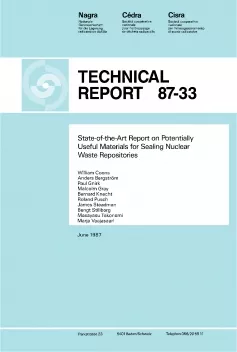
Technical Report NTB 87-33
State-of-the-Art Report on Potentially Useful Materials for Sealing Nuclear Waste Repositories
This state-of-the-art report has been prepared by the members of the technical OECD/NEA-sponsored Stripa Task Force on Sealing in furtherance of Phase III of the Stripa Project. The objectives of the report are: 1) to review progress in the development of seal materials and emplacement techniques; 2) to identify priority issues and materials for sealing narrow aperture fractures; and by so doing, 3) to provide a basis for developing seal test programs such as that intended for implementation at the Stripa Facility.
A system of seals may be a desirable or necessary element to assure that repositories prevent release of unacceptable amounts of radioactive waste. Although such seals may be included in repository systems, quantitative performance objectives cannot be specified generically; rather, performance specifications await definition on a case-bycase basis. Generalized performance objectives can be defined, however. These objectives include restricting water flow through the repository, working compatibility with the in situ environment and other repository barrier components, and maintaining performance over an unspecified but long duration of time (many thousands to perhaps millions of years). During analysis and recommendation of materials, practical constraints such as the ability to emplace seals, a history of successful use of the material, the availability and cost of materials, and the desire to use comparatively safe (i.e., non-toxic) materials were also considered.
The initial list of material classes analyzed included cementitious materials, ceramics, chemical grouts, clay materials, cement/clay materials, metals, and organic substances (bitumen, tars, etc.). Of these, cementitious materials and clay materials are recommended as priority materials because they can be designed to meet all of the desired performance characteristics, there is a considerable history of successful use in similar engineering applications, and there is indirect evidence that they will continue to perform for long periods of time. Chemical grouts are identified as a promising class of materials that could be very useful for specialty applications. Chemical grouts were not selected as a priority material because of their cost and because evidence for long-term performance is lacking. Cement/clay and bituminous materials may possess important performance characteristics but have uncertain long-term performance. Both chemical grouts and bitumen have uncertain effects on radionuclide mobility because of the introduction of organic substances into the repository system. Synthetic materials, ceramics, and metals, are referred in this report either for practical reasons (e.g., emplaceability) or because the ability to provide seal functions appears unlikely. Figure ES-1 illustrates an example of the material screening process and results. The significance of the figure is the process of materials screening, a technique applicable to all programs. The ranking of criteria and materials shown in the figure may vary from site to site and do not necessarily represent a consensus of all contributors to this report.
